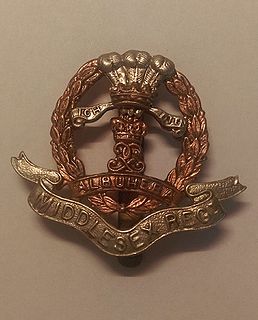The Home Counties Brigade was an administrative formation of the British Army from 1948 to 1968. The Brigade administered the regular infantry regiments of the Home Counties of south east England.

The British Army is the principal land warfare force of the United Kingdom, a part of British Armed Forces. As of 2018, the British Army comprises just over 81,500 trained regular (full-time) personnel and just over 27,000 trained reserve (part-time) personnel.

A brigade is a major tactical military formation that is typically composed of three to six battalions plus supporting elements. It is roughly equivalent to an enlarged or reinforced regiment. Two or more brigades may constitute a division.

Infantry is the branch of an army that engages in military combat on foot, distinguished from cavalry, artillery, and tank forces. Also known as foot soldiers, infantry traditionally relies on moving by foot between combats as well, but may also use mounts, military vehicles, or other transport. Infantry make up a large portion of all armed forces in most nations, and typically bear the largest brunt in warfare, as measured by casualties, deprivation, or physical and psychological stress.
After the Second World War the British Army had fourteen infantry depots, each bearing a letter. The depots were territorially organised, and Infantry Depot C at Howe Barracks in Canterbury was the headquarters for the seven county regiments of the City and County of London, Kent, Middlesex, Surrey and Sussex. [1]

World War II, also known as the Second World War, was a global war that lasted from 1939 to 1945. The vast majority of the world's countries—including all the great powers—eventually formed two opposing military alliances: the Allies and the Axis. A state of total war emerged, directly involving more than 100 million people from over 30 countries. The major participants threw their entire economic, industrial, and scientific capabilities behind the war effort, blurring the distinction between civilian and military resources. World War II was the deadliest conflict in human history, marked by 50 to 85 million fatalities, most of whom were civilians in the Soviet Union and China. It included massacres, the genocide of the Holocaust, strategic bombing, premeditated death from starvation and disease, and the only use of nuclear weapons in war.

Howe Barracks was a military installation in Canterbury in Kent.
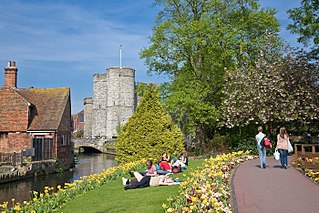
Canterbury is a historic English cathedral city and UNESCO World Heritage Site, situated in the heart of the City of Canterbury, a local government district of Kent, England. It lies on the River Stour.
In 1948, the depots adopted names and this depot became the Home Counties Brigade, with all regiments being reduced to a single battalion at the same time. The Home Counties Brigade was formally formed on 14 July 1948, combining the depots of the following regiments: [2]
- The Queen's Royal Regiment (West Surrey)
- The Buffs (Royal East Kent Regiment)
- The Royal Fusiliers (City of London Regiment)
- The East Surrey Regiment
- The Royal Sussex Regiment
- The Queen's Own Royal West Kent Regiment
- The Middlesex Regiment (Duke of Cambridge's Own)
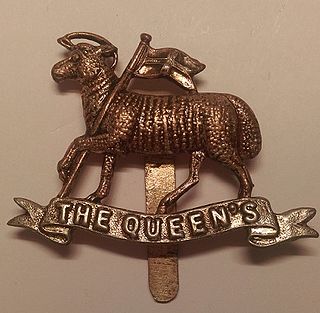
The Queen's Royal Regiment was a line infantry regiment of the English and later the British Army from 1661 to 1959. It was the senior English line infantry regiment of the British Army, behind only the Royal Scots in the British Army line infantry order of precedence.
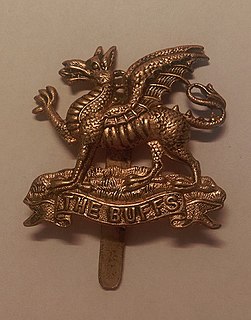
The Buffs , formerly the 3rd Regiment of Foot, was a line infantry regiment of the British Army traditionally raised in the English county of Kent and garrisoned at Canterbury. It had a history dating back to 1572 and was one of the oldest regiments in the British Army, being third in order of precedence. The regiment provided distinguished service over a period of almost four hundred years accumulating one hundred and sixteen battle honours. In 1881, under the Childers Reforms, it was known as the Buffs and later, on 3 June 1935, was renamed the Buffs .

The Royal Fusiliers was a line infantry regiment of the British Army in continuous existence for 283 years. It was known as the 7th Regiment of Foot until the Childers Reforms of 1881.
Under the Defence Review announced in July, 1957, the infantry of the line was reorganised: On 1 April 1958 the Royal Fusiliers were transferred to a newly created Fusilier Brigade, and over the next three years the remaining six regiments were reduced to four by amalgamation.
The 1957 White Paper on Defence was a British white paper setting forth the perceived future of the British military. It had profound effects on all aspects of the defence industry but probably the most affected was the British aircraft industry. Duncan Sandys, the recently appointed Minister of Defence, produced the paper.
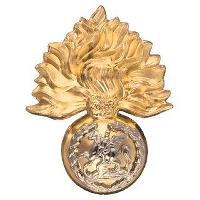
The Fusilier Brigade was an administrative formation of the British Army from 1958 to 1968. The Brigade combined the depots of the English infantry regiments designated as fusiliers.
From 1958 all regiments in the Brigade adopted a common cap badge and brigade buttons, depicting an upright sword within a Saxon crown. The individual battalions were henceforth being distinguished by their collar badges. [3] [4] [5] By 1961 the four regiments in the brigade were:
| Regiment | Collar badge |
|---|---|
| The Queen's Royal Surrey Regiment (formed October 14, 1959 from the Queen's Royal and East Surrey Regiments) | On a crowned, eight-pointed star, a paschal lamb [6] |
| The Queen's Own Buffs, The Royal Kent Regiment (formed March 1, 1961 from the Buffs and the Royal West Kent Regiment) | The white horse of Kent with the motto"Invicta" and a scroll with the regiment's name. |
| The Royal Sussex Regiment | In front of the Roussillon plume, a Maltese cross, in the centre of which was St George's cross within the Garter and a laurel wreath. |
| The Middlesex Regiment (Duke of Cambridge's Own) | The plumes of the Prince of Wales and cypher of the Duke of Cambridge within a laurel wreath, with a scroll inscribed "Albuhera" |
On 31 December 1966 the four regiments of the Home Counties Brigade were merged to become a new "large regiment": The Queen's Regiment, with the four regular battalions redesignated as the 1st to 4th Battalions of the new regiment.
On 1 July 1968 the Home Counties Brigade was united with the Fusilier and East Anglian Brigades, to form the Queen's Division. [7]




